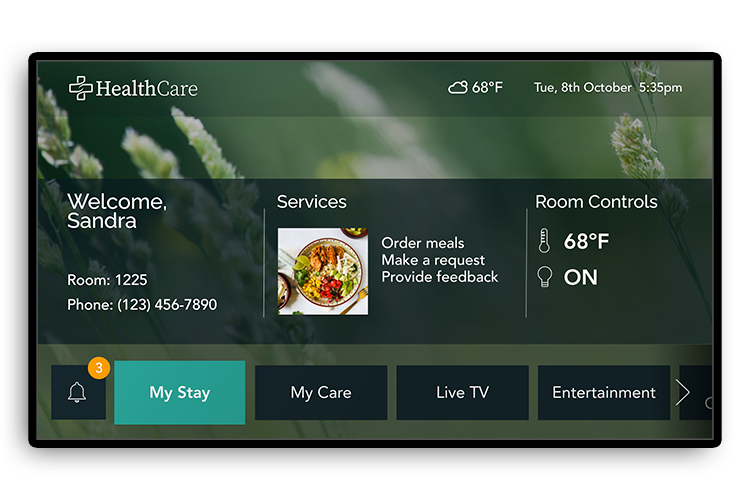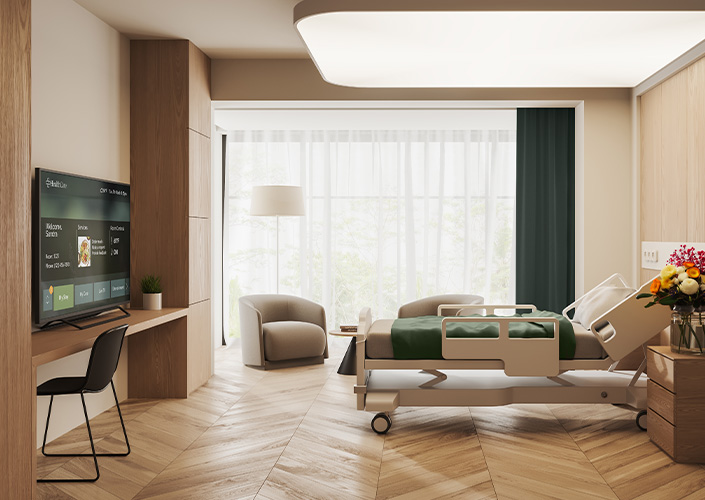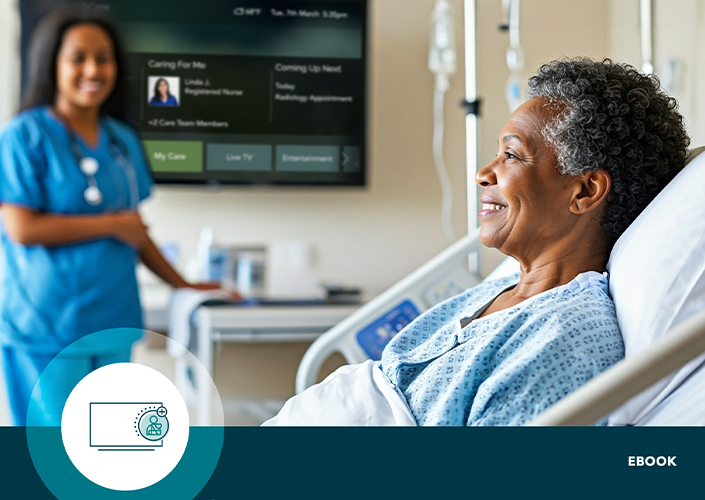How hospitality-centered technology leads to more human-centered care
 By Meghan Seus, VP Product Marketing
By Meghan Seus, VP Product Marketing Every year, patients have higher expectations for their care and more influence over a hospital’s reputation and financial outcomes.
Yet, despite these demands, most patient technology still focuses on displaying data, with less attention on creating a meaningful, engaging experience for users.
At SONIFI Health, we’ve seen a problem at hospitals across the country: patients often feel disconnected and confused by the information presented to them, while nurses struggle to balance demanding workloads of clinical care, documentation, and patient experience initiatives.
Hospitals, in turn, find themselves needing to address not just physical needs, but emotional and mental needs as well.
We knew there had to be a better solution.
So we analyzed years of data and research, tapped our team’s collective expertise, interviewed patients, families, clinicians, and executives, and worked closely with a global leader in research, consumer behavior and human-centered design.
Looking at all this together, we came to one big realization: the missing piece in patient technology was hospitality.
Not only in the service industry sense, but in the feeling hospitality evokes.
When someone enters a hospital room, they shouldn’t feel like they’re just another patient in a system.
They should feel seen, heard, and cared about—as should the people caring for them.
With this perspective, we set out to redesign the role of patient engagement technology.
Meeting the needs of all patients—and all hospitals
But every patient and every hospital is different.
There’s the 29-year-old first-time mom who is already feeling exhausted and overwhelmed.
The busy 45-year-old with a scheduled shoulder surgery who’s eager to get back to work and back on the court.
The 87-year-old who is recovering after a heart attack, only speaks Spanish, and lives with her adult son.
The spunky 6-year-old with pneumonia for the second time, accompanied by his scared parents.
The 71-year-old who’s feeling disoriented and a bit embarrassed after a fall that resulted in a concussion and broken ankle.

How could we possibly reach each patient effectively—helping them find comfort during their stay and leave feeling more confident after discharge?
All without adding more to staff workloads, and instead making it easier for them to get back to direct patient care?
While also supporting each organization’s unique priorities, from education compliance to readmission rates, virtual care efficiencies, patient experience, safety and quality, HCAHPS, health equity, and beyond?
That’s the challenge our team took on, and it’s what guided our design process every step of the way.
Where to focus and why
Nearly all patient rooms already have a TV, and it’s something virtually everyone is familiar with using.
So that’s where we decided to re-envision what the user experience could be.
By making the TV a central resource for patients, we reduce learning curves and increase the likelihood of engagement, allowing patients to navigate their hospital stay with less confusion and need for staff involvement.
SONIFI Health’s system already integrated with EHRs, patient education, and clinical tools, but we knew we could improve how patients, families, and staff interacted with it.
Our goal was to bring a sense of hospitality to the experience, anticipate user needs, and provide easy-to-understand information when it’s needed most.
The result of leading with hospitality
We recently released a comprehensive ebook that walks through the insights we gathered, the changes we made to the new user experience, and why it is being selected time and time again by healthcare organizations to help meet their goals.
At a high level, our new interactive TV system was designed to make people feel welcomed and comforted as we help guide them through their stay, offer conveniences that make things simple, and set them up for success after they leave the hospital.
We made sure the information patients ask for most—like who’s on their care team, what their plan is for the day, and what they need to do before discharge—was easily accessible without overwhelming them.
Proactively delivering the right information at the right time helps ease stress for everyone involved.
Plus, family members get clear updates and information on how they can support their loved ones, while nurses benefit from automations that reduce non-clinical tasks, allowing them to focus more on care.

Transforming the hospital experience together
At the heart of this redesign is the desire to make hospital stays more human-centered.
By providing access to education, entertainment, and care information in one easy-to-use place, we’re reducing the anxiety that comes from feeling uninformed or out of control and replacing it with a sense of authority, confidence, and trust.
Our technology goes beyond displaying data—it’s helping people feel truly cared for, and cared about.
And when hospitals can create these positive experiences, the impact goes far beyond the patient’s stay. It fosters brand loyalty, improves outcomes, and reinforces the hospital’s reputation for exceptional care.
In the end, it’s not about what technology can do, it’s about how it makes people feel. And that’s the real shift patient engagement has needed.
***
Editor’s note: This article originally appeared in Modern Healthcare.
Stay connected
Get exclusive insights delivered to your inbox from our experts.

